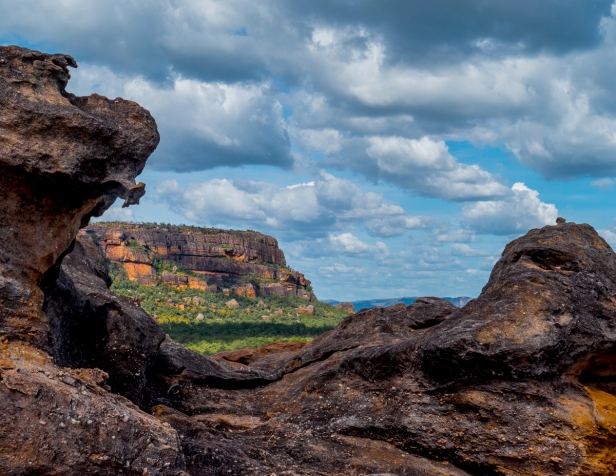
15 April 2015. After driving for about half an hour from our cabin in the campground near the small town of Jabiru, we arrive at the bush car park ready for a hike. We step out of the car into an oven. It’s mid April and the high for the day is as usual around the mid to high thirties (close to 100F). The heat is not unexpected. What is unexpected is that I don’t have my sun hat. I must have left it behind at the ranger station. I am stunned. How could I have done such a thing?! I can’t hike without it, especially since I have no hair.
Even though it is unlikely we will be swimming, for some reason Don had put his swimming shorts in the car along with a towel. His shorts become my new hat. Looking ridiculous but hoping to avoid serious sunburn,
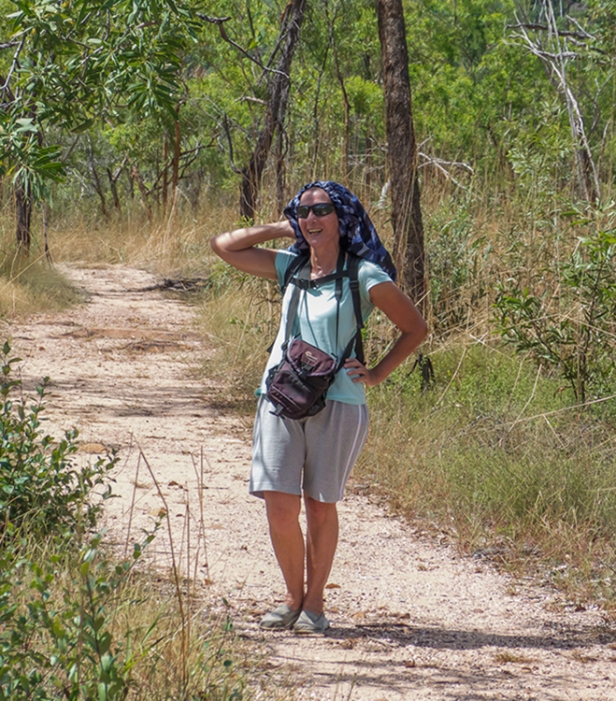
we happily set off on a six-kilometre walk to Gubarra Pools through the wet-season forest of Kakadu National Park in Australia’s “Top End”.
World-Heritage-listed Kakadu National Park covers almost twenty thousand square kilometres of the Northern Territory and is one of Australia’s natural and cultural icons. I’ve wanted to go there for years. In my twenties one of the walls of each of the various apartments I lived in was graced with a huge poster of Kakadu scenery. Finally I was getting to see the real thing.
We pass a warning sign: “Crocodiles inhabit this area”.
Very soon we come to a long stretch of water on the track. Don asks “Do we really want to do this?” I ask him what his hesitation is about. It’s about the crocs! There are both saltwater and freshwater crocodiles, known as salties and freshies, throughout the park and honestly neither of us knows if this stretch of water on the track is enough to attract them or not. It is at least shallow enough that we’d see them in the water, but not necessarily in the grass on either side of it.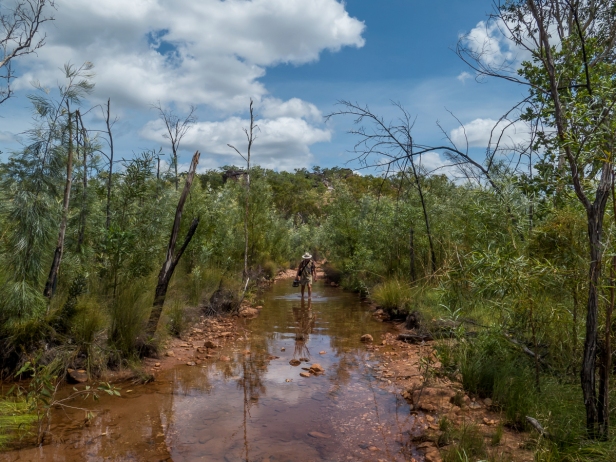
Earlier we’d stopped in at the park information centre and had been told we should have three-and-a-half litres of water each for a twelve-kilometre walk. The ranger stressed this. He said they’d found a German man who didn’t have enough water. “We found his body three days later. He wasn’t breathing.”
I’m thinking we should have at least one-and-a-half litres of water each for a six-kilometre walk and I know we’re not carrying that much. So now I’m anxious about crocs and water. I’m aware of this anxiety as I continue walking through the water on the track. I’m aware of the fear but I’m determined that it’s not going to stop me. I wade on through the water, with Don following behind me. We make it through. Phew! So far so good. I think of the dangers of dehydration and crocs and choose to surrender. I’m not going to do this hike in fear. That’s no fun. What will be will be.
I’m aware that I need to pee but choose not to. If I just keep on walking the body will reabsorb it. It’s always worked in the past. I’m not wasting any water.
It’s an imposing landscape: still and silent and powerful. I feel as if I could be swallowed whole by it. It has a power and majesty that envelops me. The land feels sacred, as if I’m walking on hallowed ground. I’ve never felt anything quite like this before. Perhaps I have aboriginal ancestors, or was aboriginal in a past-life. It is deeply familiar. All land is holy ground, but in this place I really feel it.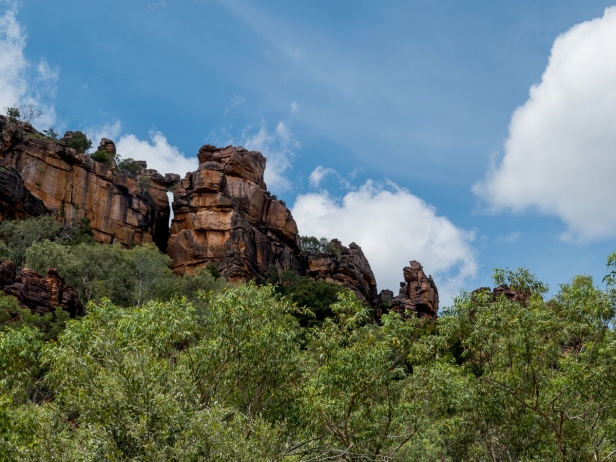
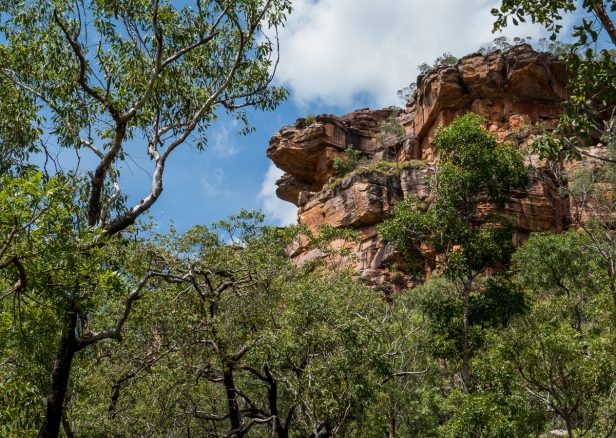
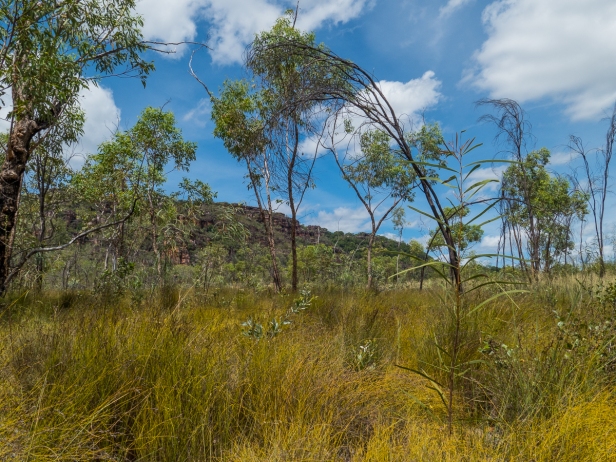
As we walk we come across wildflowers,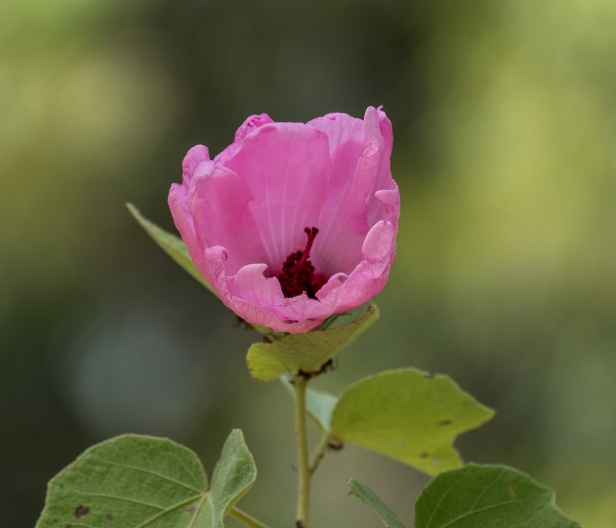

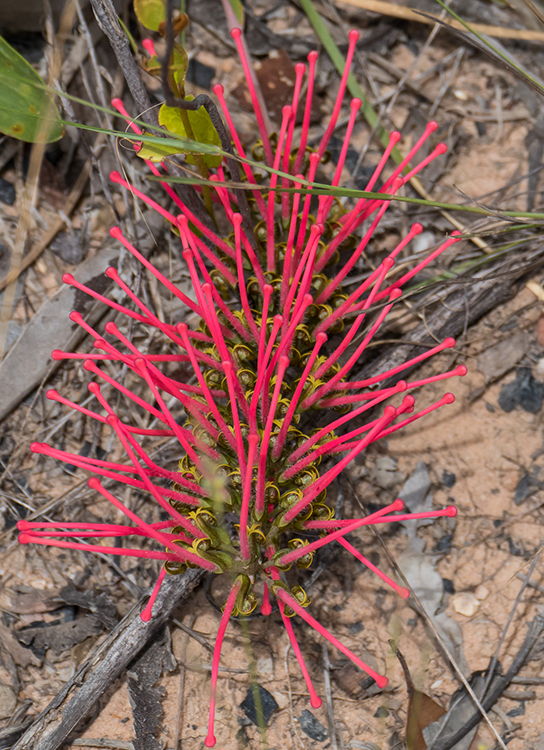
a Peaceful Dove,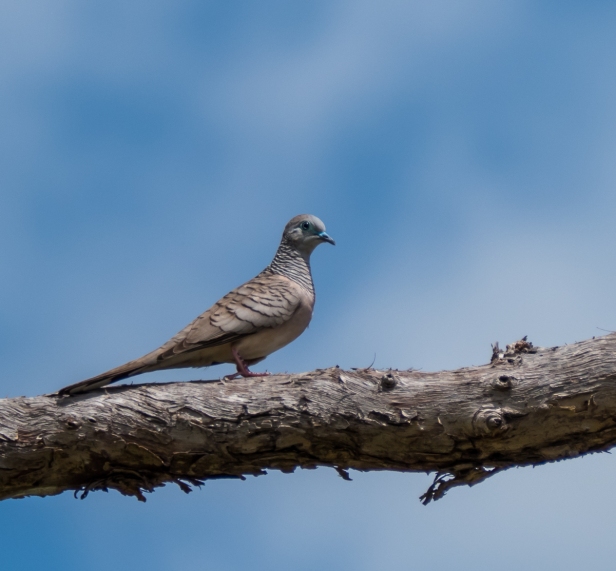
and a dragonfly bush fairy.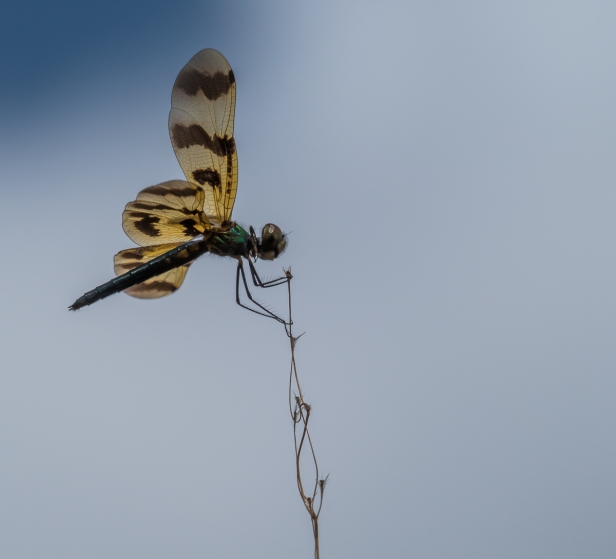
We walk on, eventually coming to the end of the trail at a river. The croc signs are there again. “Crocodiles inhabit this area. Don’t go too close to the water”. People are coming towards us from the river and tell us there are no crocs, only big spiders. We don’t see spiders but we do see this bug.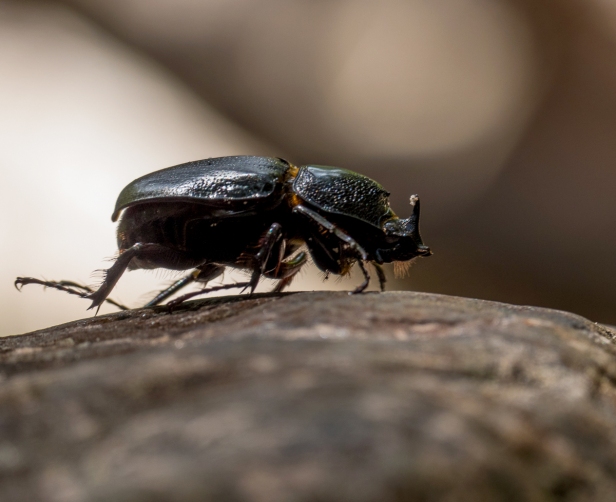
We go a bit further, scrambling over rocks now, and decide we’re done; it’s time to turn back. The whole way we’ve been rationing water, a few sips here and there, but making sure to keep half for the return journey. I still need to pee.
It’s harder than we imagined. And slow. The heat saps our strength. I’m aware of being thirsty, of the body needing water. I feel the body hunching over. In extreme cold we tend to hunch over to try to keep warm. I notice in the heat that the same hunching occurs, but for a different reason: I have no strength to stand up straight. I have only enough energy to keep putting one foot in front of the other.
It seems to take forever. The heat is relentless. We are both aware of how over-heated our bodies are. Every now and then, for a few brief seconds, there is the sheer bliss of a slight breeze coupled with the shade from a tree or a cloud passing in front of the sun. Each time it happens I see how little is needed for respite. Shade and a breeze. But each time it is short-lived. I take a few more gulps of water. I’m so hot I’m vaguely afraid I’ll pass out. I don’t actually know how hot the body can get before it can’t take any more. I still need to pee.
And then the end comes. Suddenly we are back at the car. I have a little water left, Don quite a bit more. We have more water in the car. I finally check the size of our water bottles: three-quarters of a litre, half what we should have taken. We climb into the car, turn on the ignition, turn the AC up full blast, drink more water and high five each other! Fun! Now that it’s over.
Later we climb one of those imposing escarpments for glorious sunset views of the valley beyond, lush and green from the wet-season rains.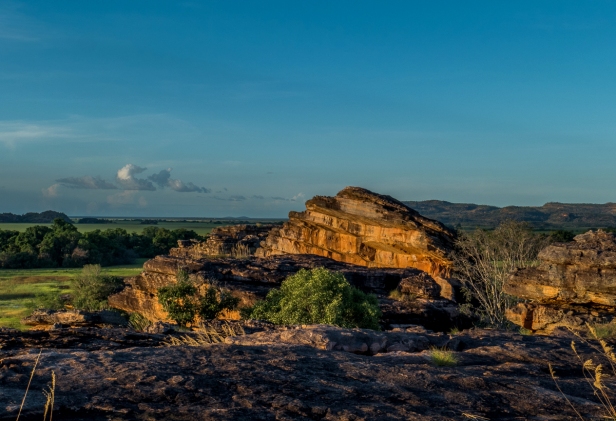
19 April 2015. After a two-hour drive to the south end of the park, we set off again, this time hiking only about four kilometres to Motor Car Falls. Right from the start we meet Mathilde and her mum Viviane from France and we hike with them through the dry grasses and relentless heat.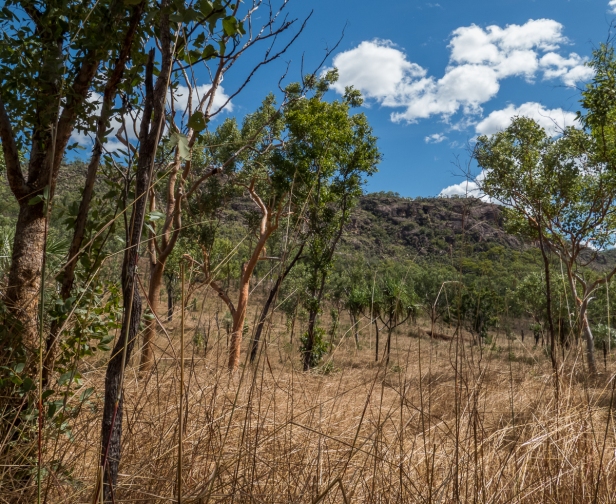
Eventually we come to the river, and this time we are not afraid of crocodiles, even though perhaps we should be.
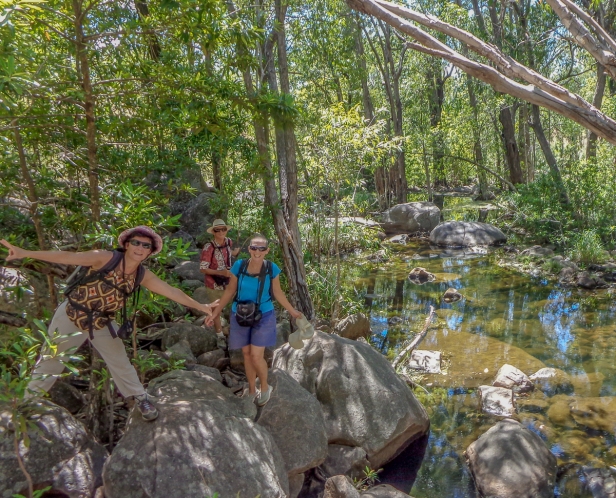
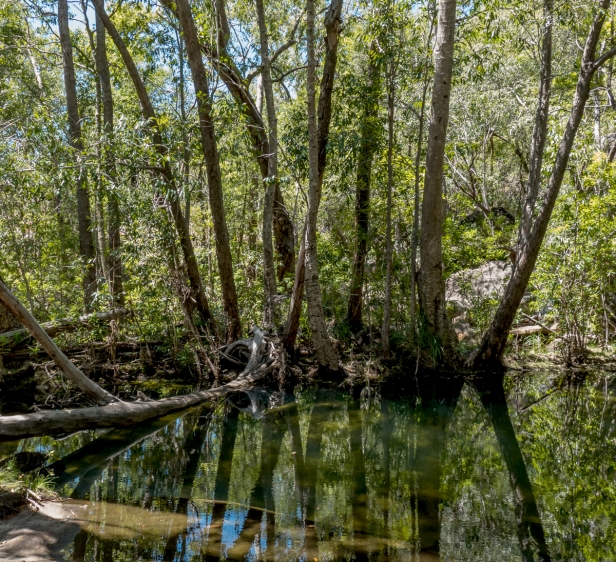
This is what Parks Australia has to say about swimming in Kakadu National Park: The safest places to swim are the public swimming pool in Jabiru and the pools at the various resorts and hotels. We don’t recommend that people swim in Kakadu’s waterways, but some people choose to do so at their own risk.
Some places are safer to swim than others. Some of the pools up on the escarpment, above the waterfalls, are less likely to be accessible to crocs. We go to lots of effort to clear certain areas of crocodiles, but they can move back in at any time.
We go ahead and swim anyway. How could you not swim in a place like this?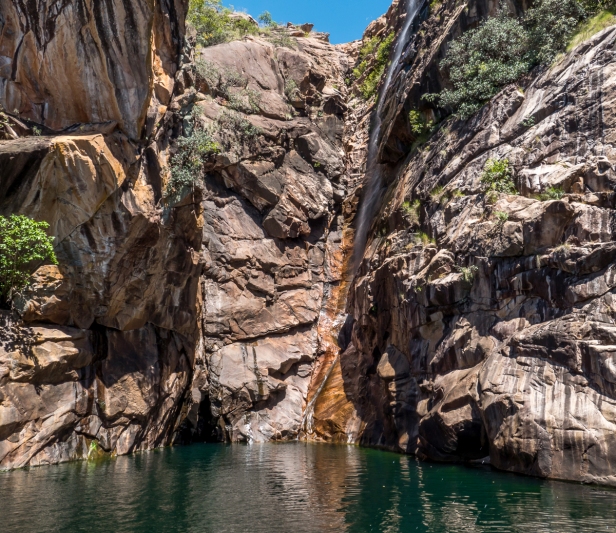
Small groups of people come and go, but it is never crowded. We swim, we laze around, we eat lunch sitting in the gentle shade on the smooth rocks, we swim some more. The water is cool and delicious.


Later, making my way around some rocks and under some low hanging branches, looking for the best spot to photograph the pool, I find this gorgeous creature: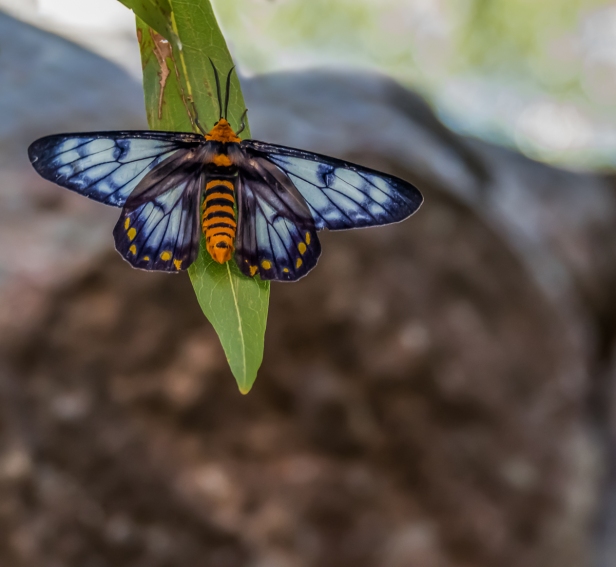
Sometime about mid-afternoon we decide it’s time to head back. It’s about 38 degrees (100F) and even though we have much more water with us this time, and have cooled off swimming, the walk out is no easier than the walk out from Gubarra Pools, but this time there is no fear of dehydration or crocs.
More to come about Kakadu and the Top End – jumping crocs and jabirus, ancient cave art and aboriginal magic, flooded rivers, hot springs, and gorges.
All words and images by Alison Louise Armstrong unless otherwise noted
© Alison Louise Armstrong and Adventures in Wonderland – a pilgrimage of the heart, 2010-2015.


That pool looks absolutely beautiful (well actually all of it looks stunning). You were very brave about the crocs too!
LikeLiked by 1 person
Thanks Emily. The pool *was* beautiful! Just heavenly. I guess we were a bit brave about the crocs, but it was either that or miss out so we just forged ahead.
Alison
LikeLiked by 1 person
Wonderful Post.
LikeLiked by 1 person
Thank you so much Mukul.
Alison
LikeLike
Wonderful storytelling. I was hanging off every word waiting for sightings of crocs, learning in the process that my own sense of adventure has its limits. Thank you for such an interesting post. I’ll look forward to more on the Top End.
LikeLiked by 1 person
Thanks so much Anne. I really appreciate your comment on my writing. It’s very encouraging. Much more on the Top End to come – it was definitely one of the highlights of our time in Australia.
Alison
LikeLike
beautifuls
LikeLiked by 1 person
Thank you San. I’m glad you enjoyed it. Kakadu is a very beautiful place for sure.
Alison
LikeLiked by 1 person
Beautiful as always. We lived in Darwin for 3 years and our favourite swimming spot was the beautiful pool down at Howard Springs as it was safe and croc free. The year after we returned to Canberra they trapped a very large 2 metre saltie in the pool……thanks as always for the lovely photos.
LikeLiked by 1 person
Thanks Ros, glad you enjoyed the post. I’m glad you got out of Darwin before a saltie arrived at Howard Springs! We heard some scary stories about the crocs that I’ll be relating in future posts.
Alison
LikeLike
Wow! The colours are amazing. Love the photo of the two of you on the rock 🙂 xx
LikeLiked by 1 person
Thanks A. This whole part of the country is amazing. Have you been there? You should go! It was a lifelong dream of mine and I finally made it.
Alison
LikeLike
I haven’t been there…so much to see 😉
LikeLiked by 1 person
What beautiful raw nature and how lucky you were there. Not a sign of technology in sight and that’s a lovely view from my perspective. 🙂
LikeLiked by 1 person
Thanks Paulette, and yes how lucky we were to be there – no technology at all, just beautiful nature for as far as you could see. I don’t think they’ll be putting any cell towers in Kakadu any time soon except for the ones already there in the small town of Jabiru.
Alison
LikeLike
What a fabulous adventure! You will always be glad you did it.
LikeLiked by 1 person
Oh yes, a fabulous adventure! And yes we’re very glad we did it. The whole Top End adventure was amazing.
Alison
LikeLike
What an exciting hike! You are an inspiration, as always. We were just tin Florida and Louisiana and were wondering if crocs/gators ventured into salt water as well. Now we know.
LikeLiked by 1 person
Thanks so much Robyn. Well yes, it was a pretty exciting hike. Both hikes were really worth it. I don’t know if there are salt water gators, but there are definitely salt water crocs. I’d love to get to Florida and Louisiana one day.
Alison
LikeLike
That pool would definitely entice me on a hot day. I am reminded of the pool in Crocodile Dundee. 🙂 As for walking in the heat of the day, it can be worrisome. Good thing you had the trunks to wear. Heat stroke is nasty. Getting your clothes wet helps too. Beautiful park and great photos as always. –Curt
LikeLiked by 1 person
Thanks Curt – yes it’s a very beautiful park. And huge. It’s quite possible it’s the same pool because Crocodile Dundee was filmed in Kakadu National Park. We often walk in the heat of the day but always make sure we have plenty of water – don’t know what we were thinking to set off with so little, especially as we had more in the car. And yes, it’s a very good thing I had Don’s trunks. I’d not have gone out in that heat with my head not covered.
Alison
LikeLike
You guys are tough!!
LikeLiked by 1 person
Ha! Thanks SGMT! Or crazy? Not sure which. 🙂
Alison
LikeLiked by 1 person
Great adventure for us to have in the comfort of our home. Beautiful pics as well. Thanks for your posts, always looking forward to the next.
Mary
LikeLiked by 1 person
Thanks Mary. Happy you enjoyed this adventure, and the pics of this beautiful part of the world. More to come from the Top End – it’s an amazing place.
Alison
LikeLike
i’m grateful for
this refreshing holiday
thanks to your effort
of eloquently sharing 🙂
LikeLiked by 1 person
Thank you for sharing
your appreciation
of refreshing pools
and hot adventures.
Alison
LikeLike
Love the pics, love the story – years ago I was caught in an unending hike where the water ran out. It was what my husband later referred to as a ‘death march.’ He had remembered the distance wrong. We have this kind of arid topography here in Hawaii as well – and there, past the kiawe scrub, past the rocky shore, lies the ocean. Water! Salt! I never want to go through that again. We always caution tourists to be sure and take enough water on their hikes here. We’ve seen some pretty dire looking kids and older folks who were lucky to get back to their cars. Take care! Enjoy the crocs, if you can see them!
LikeLiked by 1 person
Thanks Bela. That ‘death march’ sounds horrible. I never knew there were any arid places in Hawaii. I always think of it as lush tropical, even though we went to a desert plant botanical garden on Oahu. We’ve definitely become more vigilant about water since that hike, though we always were before that, we just had an off day or something. We got to see plenty of crocs – to come in future posts 🙂
Alison
LikeLiked by 1 person
Yay, crocodiles! 😀
LikeLiked by 1 person
Oh the water looks so magical. Im glad you didnt encounter any but its very easy to imagine why the crocs would want to come back to the waters!! 🙂
LikeLiked by 1 person
Yes, it was indeed magical. A very secluded and beautiful place. We saw crocs in the water and on the shores in other parts of the park. Glad they stayed away from that swimming hole!
Alison
LikeLiked by 1 person
I can sense your relief when you got back to the car…crocs, dehydration (make for a great story once safe and sound). Wonderful photos. By the way, the “hat” looks very stylish.
LikeLiked by 1 person
Thanks Caroline. When I saw the car I was soooo relieved. And yes, a great story when it ends safely. Isn’t that ‘hat’ the bees knees?! So chic! It added to the heat but served the purpose well.
LikeLike
I just want to leave and travel every time I read your posts…lovely spaces again ☺️
LikeLiked by 1 person
Thank you so much. That is a lovely compliment and much appreciated.
Alison
LikeLiked by 1 person
Really I just do want to fly away ☺️
LikeLiked by 1 person
# keep travelling happy traveller
LikeLiked by 1 person
Thank you, we will. It seems to suit us.
Alison
LikeLike
Well, thank goodness you were not wearing a bathing suit on your head when you met the French ladies! So un-chic! Haha – very resourceful, actually.
LikeLiked by 1 person
Ha ha. As it happens the French ladies were dressed for the bush as well. I think they’d have been amused by my hat 🙂
It was either wear Don’s swimming trunks or not go, and in my mind not going was not an option.
Alison
LikeLiked by 1 person
I’m so glad you soldiered on despite the heat and your fear of crocs because all of your photos are absolutely amazing! We’ve had many experiences like this one where we’ve slogged on and on despite the heat or other uncomfortable things (with me needing to pee too!) only to have these places turn out to be some of our best memories. P.S. And you managed to add a certain bit of flair to your headpiece! Anita
LikeLiked by 1 person
Thanks so much Anita. I’m glad we soldiered on too. Overall it was a good experience, especially the outward trek, being out alone on that land for several hours – it’s so powerful. The ‘hat’ was of course absolutely essential.
Alison
LikeLike
Thanks for sharing! This brings up so many memories 🙂 I spent about 4 months living near Kakadu – mostly working on a cattle station. It’s my favourite place in Oz! I also got to work with Aborigine tour guides who took us to so many pretty waterholes – I agree it’s weird going for a swim where you see croc traps in the water. Just make sure someone smaller is swimming nearby 😉 We always checked with the rangers though. And even went for croc watching at night (their eyes reflect the torch light and you’d be surprised how many are in some areas!) and of course at yellow waters cruise – pretty impressive!
LikeLiked by 1 person
Wow, Ina, it sounds like you had an amazing time in the Top End – a really authentic experience. We didn’t see any croc traps. Thank goodness! We did the Yellow Water cruise – very beautiful – coming in a future post.
Alison
LikeLike
I like when the writer of a horror movie forgets to include the blood-curdling climax, and everything dissolves into air-conditioning and high-five’s. I like that a lot. It’s also kind of surreal that in today’s world you can step out of the Dreamtime and directly into a rental car. 🙂
It was great to see photos of you guys in the mix, and I cannot not comment on the lovely echoes between the dove’s wing feathers and the curled bark of the branch beneath it. Nature is such a sublime enfolding.
Much Love to you both–
Michael
LikeLiked by 1 person
Good ending eh?! And yes – surreal going from the dreamtime to the car’s AC. Once I got over my fears much of it really was like being in the dreamtime – the land is powerful and insistent in a way I’ve not experienced before.
So both Don and I had to have another look at the dove and the branch to see the matching patterns. Beautiful. Thank you for your seeing, and sharing.
Alison
LikeLiked by 1 person
Wow, gorgeous!! And the “Bush Fairy” photo is just exquisite! She is so delicately at work.
LikeLiked by 1 person
Thanks Kelly. It really is gorgeous country. And you noticed the fairy! It’s one of my favourite photos ever.
Alison
LikeLiked by 1 person
Such a magical place and you have captured its spirit. I look forward to more of your posts on this very special part of Australia.
LikeLiked by 1 person
Thanks pommepal. It is definitely a magical place. We were completely enchanted when we weren’t worried about crocs and dehydration. Several more posts to come.
Alison
LikeLike
We loved it there and I’ll look forward to your next posts.
LikeLiked by 1 person
What an adventure! I get a bit of the holy ground feeling from your pictures – it looks primeval and powerful in a way that a lot of modern landscapes don’t. I’m so glad you weren’t eaten by crocodiles!
LikeLiked by 1 person
Yeah, it was an adventure! So glad we did it even though it was a bit worrisome there for a while. Primeval is exactly the right word for it. I’ll be doing a post soon on the Aborigines who live there – they fit into the land in a completely natural organic way that we could only dream about. That’s it actually. They dream it, so it all flows.
I too am glad we weren’t eaten by crocodiles! 🙂
Alison
LikeLike
I think I missed this post while grading papers!! You’re like becoming the Yoda for photos of bugs and especially dragon flies. And mountains. And clouds. And Don.
LikeLiked by 1 person
I think I missed this comment while being dazed and confused! Just discovered it now. Thank you for your long time ago compliment. I love Australian dragonflies (as opposed to Canadian ones) – they pose for you.
I take it you’re not blogging these days. I see you on FB now and then.
Alison
LikeLike
I believe it’s really the letting go that allows us to experience the landscape fully. Thank you for introducing me to this post, Alison!
LikeLiked by 1 person
Yes, I agree about the letting go. I seem to really get a feel for the land when I drop deep into presence and let myself become a part of it. Outback Australia seemed to reach out and grab me.
I’m glad you enjoyed the post.
Alison
LikeLiked by 1 person